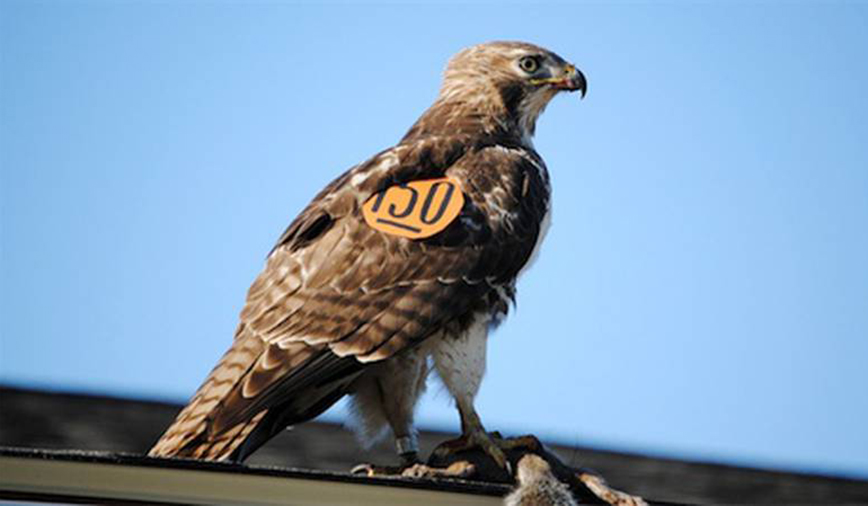Pam’s Perspective
From the…
Pam Otto is the Manager of Natural Programs and Interpretive Services for the St. Charles Park District
December 28, 2012
Birding can be tricky business this time of year. Many of our most recognizable species are gone for the cold-weather months, and those that opt to stay are decked out in winter drab. Except for blue jays and male northern cardinals, and flashes of red on certain woodpeckers, the forecast for plumage colors this season calls for mostly shades of brown, gray, black and white.
Oh, and, for a few special individuals, blaze orange.
With black numbers.
Yep, certain red-tailed hawks in our area are this year sporting wing tags, ornaments signifying their role in a study being carried out by the U.S. Department of Agriculture’s Animal and Plant Health Inspection Service’s Wildlife Services.
At this point you’re probably thinking, “Jeepers, I’ll bet there’s more to this story.”
If that’s the case, you indeed would be right.
Here’s the skinny: To help minimize the chance of mid-air collisions, wildlife biologists stationed at major airports—in this case O’Hare—commonly capture and relocate raptors that turn up on airport property. But moving these big guys around, while providing a solution, also creates more questions—namely, where do the relocated birds ultimately decide to settle? Do they integrate into new territory near their release sites? Or do they try to make it back to ORD?
In an effort to find some answers, the WS team at O’Hare began tagging red-tailed hawks about three years ago. Those first hawks, in 2010, were given green tags with white numbers. The 2011 hawks received white tags with black numbers. And this year’s group, as noted above, sport orange tags with black numbers.
The researchers are marking about 200 birds each year, attaching a weatherproof tag to the patagium, or fold of skin where the wing attaches to the body, to each individual. The hawks are then released at various distances—50, 75, 100 and 125 miles–due west of O’Hare. The goal is to see whether distance makes a difference in return rates.
But since the researchers can’t be everywhere, all the time, they need our help. Travis Guerrant, a district supervisor for USDA WS, says he and his colleagues would appreciate folks in our area keeping an eye out for tagged hawks, and relaying as much information as possible if and when a tagged bird is spotted. “Most important is the color of tag and the tag number, Guerrant said in a recent email. “A picture of the bird may also help identify the number on the tag. In addition, provide the time, date and location of where the bird was spotted; GPS preferred but general location is acceptable.”
Think the chances of you seeing one of these birds is slim? Think again.
Coworker Lisa O’Brien, who has a knack for spotting all sorts of wildlife curiosities (including a wild—and state-endangered—Blanding’s turtle by a bike trail in West Chicago and, more recently, an intriguing and rapidly expanding line of burrows along an embankment on Route 38 near Pouley Road) a few weeks ago noticed a tagged redtail off of Route 38 west of Route 47.
Driving, as she was, Lisa’s first responsibility was to be safe while simultaneously remaining courteous to other motorists. So an abrupt stop, veer and/or u-turn were out of the question. Which means the only info she was able to gather was a) red-tailed hawk; b) perching; and c) with a white tag with black numbers on its wing.
Even though Lisa wasn’t able to discern the number on the tag, or snap a photo, just noting the color of the tag indicates that the hawk she saw was relocated sometime during 2011.
Has this bird decided to make Kane County its new home? That’s where you come in.
If you, or someone you know, have seen this or any tagged redtail in the area, do your best to document the sighting, then let Guerrant and his fellow researchers know.
The main contact for the project is Craig Pullins, who can be reached at 773-686-6742 or Craig.K.Pullins@aphis.usda.gov. Guerrant’s contact info is 773-686-6955 or Travis.Guerrant@aphis.usda.gov.
Incidentally, I wouldn’t mind hearing about your finds either. Much as we try to be, we naturalists can’t be everywhere, all the time either. Although that would make a dandy New Year’s resolution.
Happy almost-2013 from your friends at Hickory Knolls!
Pam Otto is the manager of nature programs and interpretive services at the Hickory Knolls Discovery Center, a facility of the St. Charles Park District. She can be reached at 630-513-4346 or potto@stcparks.org.

